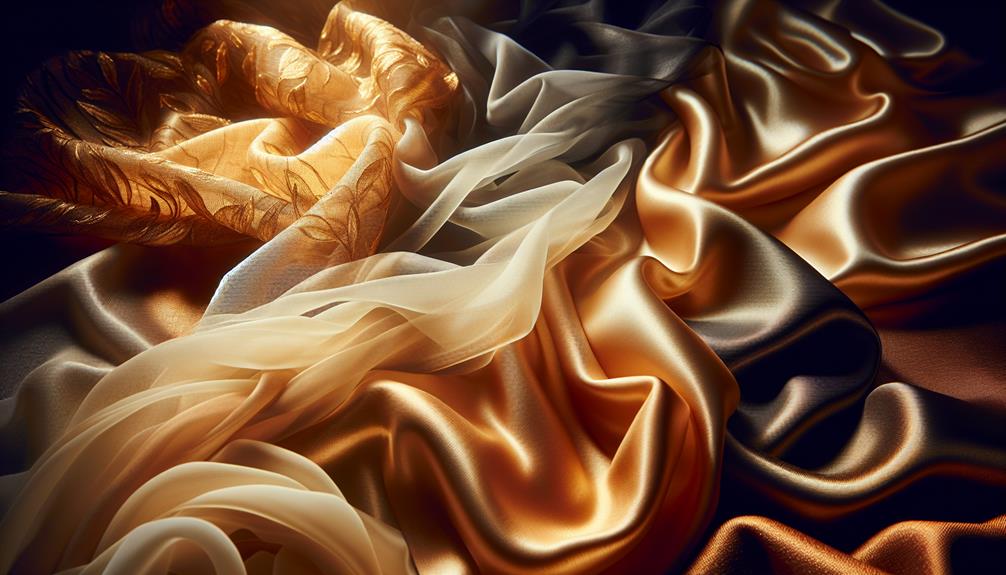In my experience, I've noticed that silk tends to be more expensive than chiffon. The main reason is that silk is a natural fiber requiring more time and effort to produce. Harvesting silk from silkworms and weaving it into fabric is a labor-intensive process, which bumps up its cost. On the other hand, chiffon, especially when made from synthetic materials like polyester, is cheaper to produce due to less labor-intensive methods and more automated processes. The demand for silk in high-end fashion also pushes its price higher. Curious about how these fabrics differ in use and maintenance? There's more to uncover.
Table of Contents
Key Takeaways
- Silk is generally more expensive than chiffon due to its labor-intensive production process.
- Chiffon often uses synthetic fibers, making it less costly and more automated in production.
- The luxurious and natural qualities of silk contribute to its higher market price.
- Market demand for silk, especially in high-end fashion, further elevates its cost compared to chiffon.
- Silk's intricate harvesting and weaving processes significantly increase its overall production and labor costs.
Understanding Chiffon and Silk
To get a handle on the differences between chiffon and silk, it's crucial to understand what each fabric is and where it comes from. Chiffon is a lightweight, sheer fabric made from cotton, silk, or synthetic fibers like nylon or polyester. It's known for its mesh-like weave, which gives it a slight stretch and a rough feel. What's interesting about chiffon is its airy quality, which makes it perfect for draping and layering in garments.
Silk, on the other hand, is a natural protein fiber obtained from the cocoons of the silkworm. This fabric is highly prized for its smoothness, sheen, and soft texture. Silk is inherently strong, despite its delicate appearance. It's versatile but tends to be more expensive due to its natural origins and the complex process of harvesting and weaving the fibers.
Understanding these basics, you'll notice that while both fabrics share a common use in fashion for their draping qualities, they originate from very different sources and possess distinct characteristics. This foundational knowledge sets the stage for exploring why one might be more expensive than the other, considering factors like production costs and material availability.
Historical Context of Both Fabrics
Let's take a quick look back in time to understand how silk and chiffon came into the picture.
Silk has been around for ages, with its trade kicking off thousands of years ago in Ancient China.
On the other hand, chiffon is a newer player, having been developed in the early 20th century, but it's had a significant impact on fashion since then.
Silk Trade Origins
Silk's journey as a highly sought-after fabric began over 4,000 years ago in Ancient China. Initially, it was a closely guarded secret, making it all the more desirable. The Chinese managed to keep silk-making techniques under wraps for thousands of years, trading the fabric through the famed Silk Road.
This route wasn't just a single path but a sprawling network of trade routes connecting Asia with the Middle East, Africa, and Europe. Silk became a major player in global trade, influencing economies and cultures far beyond China's borders. The exclusivity and labor-intensive process of silk production meant that it was often a luxury item, reserved for the elite and royalty across various civilizations.
This historical exclusivity still influences its value today.
Chiffon Development Timeline
Chiffon, unlike silk, doesn't have a millennia-old history but emerged much later, around the 1700s in France. It's fascinating how this fabric, initially exclusive and costly due to its intricate manufacturing process, became more accessible as technology evolved. Here's a quick rundown that I think you'll find pretty interesting:
| Year | Event |
|---|---|
| 1700s | Chiffon development begins in France. |
| 19th Century | Industrial advances make production cheaper. |
| Early 20th C. | Chiffon becomes popular in fashion. |
| 1950s | Synthetic fibers introduced, diversifying use. |
Key Characteristics of Chiffon
Why should you consider chiffon for your next project? Well, let's dive into what makes chiffon stand out.
First off, chiffon is remarkably lightweight; it's one of those fabrics that floats around you, creating an elegant silhouette that's hard to achieve with heavier materials. It's sheer too, which means it layers beautifully without adding bulk.
Chiffon's slight stretch is another key feature. Unlike stiffer fabrics, chiffon has a bit of give, thanks to its slight elasticity. This makes it a dream to work with, especially if you're crafting garments that need a bit of flow or movement.
Durability mightn't be the first thing you think of with such a delicate fabric, but chiffon holds up surprisingly well for its weight. It resists pilling, and while it does snag, proper handling and care can minimize this risk.
And let's not forget, chiffon drapes like a dream. Whether you're making a breezy summer dress or a formal gown, the way chiffon falls and moves with the body is just mesmerizing. It's these characteristics that make chiffon a go-to for designers looking to combine elegance with comfort. So, for your next project, chiffon could be just the ticket!
Key Characteristics of Silk
Like chiffon, silk has its own unique set of characteristics that make it a favorite among fabric enthusiasts. I've always been fascinated by how this natural fiber, produced by silkworms, offers both elegance and practical benefits. Here's a breakdown that'll help you appreciate silk just as much as I do:
- Natural Protein Fiber: Silk is a natural protein fiber. It's made by silkworms as they spin their cocoons. This natural origin gives silk a unique chemistry, beneficial for its biodegradability and comfort against the skin.
- Strength and Durability: Despite its delicate appearance, silk is incredibly strong. It's one of the strongest natural fibers, making it highly durable for its weight.
- Thermal Regulation: Silk is thermally stable. It can keep you cool in the summer and warm in the winter, making it an ideal fabric for year-round clothing.
- Hypoallergenic Properties: Silk is naturally hypoallergenic. It's resistant to dust mites, mold, and other allergens, which is a boon for those with allergies.
- Luxurious Feel: The feel of silk is unmistakably luxurious. Its smooth, soft texture makes it a highly sought-after material for high-end fashion and bedding.
Understanding these characteristics really shows why silk holds such a prized status in the world of textiles.
Factors Affecting Fabric Prices
Understanding what drives the cost of fabrics can be quite complex, involving factors from raw material availability to production techniques. As someone who's always been fascinated by how things are made and what they cost, I've learned that the price of a fabric isn't just about the material itself. It's about the entire journey from source to store.
Let's break it down with a simple table that shows some major price-influencing factors:
| Factor | Description | Impact on Price |
|---|---|---|
| Raw Material | Cost of fibers like silk, cotton, or polyester. | High |
| Production Process | Complexity and time involved in manufacturing. | Moderate to High |
| Labor Costs | Wages paid to workers involved in fabric production. | High |
| Supply Chain Length | Number of steps from raw material to final product. | Moderate |
| Market Demand | Consumer demand influencing production and stock. | Variable |
Each element in this table plays a crucial role. For instance, silk is notorious for its high raw material cost due to the laborious process of harvesting and spinning. On the other hand, labor costs can significantly spike the price depending on where the fabric is made. Understanding these factors helps us grasp why some fabrics are pricier than others.
Comparison of Chiffon and Silk Costs
Let's look at what really goes into the cost of chiffon versus silk.
We'll start by considering how the quality of the materials impacts their price.
Then, we'll explore how production and labor costs, as well as market demand, play a role in determining what you end up paying.
Material Quality Impact
Examining the costs of chiffon and silk reveals that material quality significantly influences their price differences. When we dive deeper, it's clear that several factors tied to the inherent qualities of these materials play a crucial role:
- Fiber Source: Silk is a natural protein fiber from silkworms, making it more costly.
- Texture and Feel: Silk often has a smoother feel, which is highly prized.
- Durability: Silk fibers are typically more durable than chiffon, especially synthetic types.
- Production Complexity: The process to harvest and weave silk is more labor-intensive.
- Market Demand: Silk's perceived luxury status boosts its price compared to chiffon.
Understanding these aspects helps us grasp why there's such a price disparity between these fabrics.
Production and Labor Costs
Delving into the production and labor costs, we find that silk typically incurs higher expenses due to its intricate harvesting and weaving processes. Silk production, especially, requires a lot of hands-on labor. Workers need to carefully manage silkworms, which are fed a diet exclusively of mulberry leaves. After that, the silk fibers must be extracted from the cocoons, a process that demands precision and patience, thus increasing labor costs.
On the flip side, chiffon made from synthetic fibers like polyester involves less labor-intensive methods. The raw materials are more readily available and the production process is more automated, which helps keep costs lower. So, when it comes down to production and labor, silk ends up being pricier than polyester chiffon.
Market Demand Influence
While production costs certainly play a role, market demand also significantly impacts the prices of chiffon and silk. The fluctuating desires of consumers can make a big difference in how much you're paying. Here's why:
- Fashion Trends: If silk is all the rage, its price goes up.
- Seasonal Demand: Silk might be more popular in winter, driving prices.
- Global Influence: Events worldwide can shift where these fabrics are hot commodities.
- Luxury Market: High-end brands often prefer silk, pushing up its demand and price.
- Sustainability Concerns: More environmentally aware consumers might lean towards silk, perceived as more natural, which can spike its demand.
Understanding these factors helps us see why prices aren't just about the cost to make the fabric.
Uses in Fashion and Design
In the world of fashion and design, both chiffon and silk are celebrated for their elegance and versatility. I've found that designers often lean on these fabrics to bring a touch of sophistication to their creations. Chiffon, with its light, airy feel, is perfect for creating flowy dresses and scarves that flutter beautifully in the breeze. It's not just about looks; the breathability of chiffon makes it a go-to for those balmy summer evenings.
Silk, on the other hand, has a luxurious texture that's hard to match. It's a favorite for high-end fashion pieces like evening gowns and bespoke suits. What really sets silk apart is its versatility in texture and weight, allowing for everything from delicate blouses to hefty brocade jackets. It's also a top choice for accessories, including ties and handkerchiefs, adding a dash of class with a smooth finish.
Both materials are staples in bridal wear as well. Silk's smoothness complements the structured, often ornate details of wedding dresses, while chiffon adds a dreamy, romantic quality to veils and overlays. Understanding these fabrics' distinct qualities helps designers decide which to use to best bring their vision to life.
Care and Maintenance Costs
Caring for chiffon and silk requires different approaches, each influencing the overall cost of maintenance. I've learned, from personal experience and a bit of research, that silk can be a bit trickier (and pricier) to care for compared to chiffon. Now, let's break down what you need to know about maintaining these fabrics without draining your wallet.
Here's a quick list of care tips for both fabrics:
- Washing: Silk often requires dry cleaning, while chiffon can sometimes be hand washed with mild detergent. This difference alone can save you a bunch on laundry expenses.
- Drying: Lay silk flat to dry to maintain its shape. Chiffon, on the other hand, can handle hanging dry.
- Ironing: Silk needs a low heat setting and should be ironed inside out to avoid damaging the fabric. Chiffon, made from less delicate fibers, is more forgiving.
- Storage: Both fabrics should be stored away from direct sunlight, but silk may require more breathable storage options to prevent moisture buildup.
- Repairs: Silk is more prone to snags and tears, potentially leading to higher repair costs compared to more durable chiffon.
Knowing these specifics, you can better manage the care of your garments, keeping them in prime condition without unnecessary spending.
Making the Right Fabric Choice
Choosing the right fabric, whether it's chiffon or silk, really depends on your budget and how you plan to use it. Let's dive into what makes each fabric unique and how that fits into your needs.
Chiffon is generally less expensive than silk, making it a great option for those on a tighter budget. It's lightweight and has a slightly rough feel, which is perfect for breezy, flowing dresses or curtains that don't need the heaviness of silk.
Silk, on the other hand, screams luxury and has a price tag to match. It's incredibly smooth, with a sheen that chiffon just can't compete with. If you're looking to make a statement piece, like a high-end dress or a fancy throw pillow, silk might be worth the splurge. It also has great insulation properties, keeping you warm in winter and cool in summer.
Frequently Asked Questions
Can Chiffon or Silk Trigger Allergic Reactions?
I've wondered whether fabrics like chiffon or silk could cause allergies. It turns out, silk might due to sericin, but chiffon, typically made from polyester, is less likely to trigger allergic reactions.
Are There Eco-Friendly Versions of Chiffon and Silk?
Yes, there are eco-friendly versions of both chiffon and silk. I've found that organic silk and recycled polyester chiffon are great sustainable options that don't compromise on quality or feel.
How Do Chiffon and Silk React to Humidity?
Chiffon tends to absorb more moisture, making it feel heavier in humid conditions, whereas silk generally remains light and smooth. I've noticed silk dries faster, maintaining its luxurious feel even on damp days.
Do Chiffon and Silk Offer UV Protection?
I've always wondered how well fabrics protect us from the sun. Turns out, both chiffon and silk offer some UV protection, but they're not as effective as specially treated sun-protective clothes.
Are There Vegan Alternatives to Silk and Chiffon?
Yes, there are vegan alternatives to both silk and chiffon. I've found materials like synthetic silk, made from polyester, and other plant-based fabrics that mimic their texture and feel quite well.
- Is Chiffon More Expensive Than Silk? - April 23, 2024
- Can Chiffon Be Washed? - April 23, 2024
- Is Chiffon Good for Wedding? - April 23, 2024







